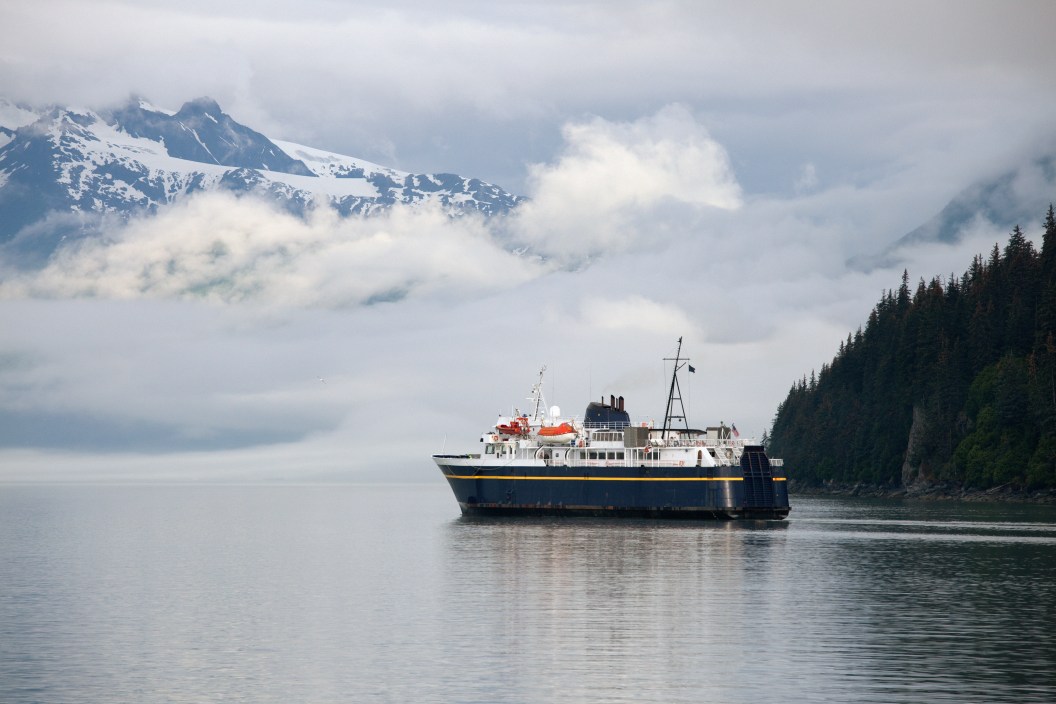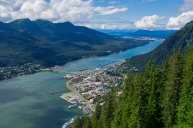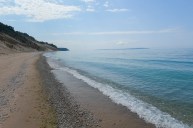Alaska is home to some of our nation's most beautiful wilderness, endless salmon runs, incredible fishing, and dream big-game hunting. Typically, visitors reach this far-north state in one of two ways: by air and by land (albeit this is the very long way).
But with its 46,600 miles of coastline, another method is plenty accessible if less common: by sea, on the Alaska Marine Highway ferries between Bellingham, Washington, and a handful of Alaskan coastal cities.
Ferries have been traversing the waters between Washington and Alaska since the 1960s, bringing both goods and people along what is known as the Alaska Maritime Highway. Run by the state of Alaska, the Alaska Maritime Highway ferry system was originally vital for connecting small, remote Alaskan communities to the wider world.
Now, it's also become a bucket-list adventure for anyone looking to step off the beaten path and onto the high seas. The Alaska Maritime Highway ferry system is perfect for those looking for a more adventurous, slower way to travel from Washington to Alaska than an airline. Take the ferry up, disembark at any of the Alaskan ports, and then fly back home. It's also a great option for travelers who are keen to drive the famous ALCAN highway from Washington to the Far North, but aren't so excited about the long return trip back. Ferry your car up, then make the drive back to the Lower 48.
Though I've lived in Alaska for nearly a decade, I've never taken the ferry myself. I have shipped my truck on it, however, and many of my friends have come up the Inside Passage from Bellingham to Alaska on it. Last summer, I needed to bring my converted camper van up from Bellingham to my cabin in south-central Alaska. With a packed work schedule guiding in the backcountry that summer, I turned to my mom for help. She'd always been interested in coming to Alaska and trying out van life but was intimidated by the long, lonely drive from Washington to Alaska.
When I told her about the ferry, she jumped on the opportunity. She flew out to Bellingham and picked up my van before spending three incredible days ferrying up the coast to Alaska. She chose to get off in Haines, driving the rest of the way to my cabin through Canada and Interior Alaska before flying back to New Hampshire. It was the trip of a lifetime for her, one that I am now keen to repeat myself.
Here's everything you need to know about the Alaska ferry, including what to expect and how to book.
What to Know Before You Book the Alaska Ferry
- The Alaska Ferry is somewhere between a granola cruise and an upscale ferry boat ride. The ferry boats lack the usual cruise ship amenities; there's no pool to swim in, no bingo nights, and no free drinks. Depending on the particular boat you take, there may be a dining room, a cafeteria, and showers, and you'll either be sleeping in a room with bunk beds or, if you don't mind roughing it, in your own tent on deck or on whatever chairs you can find to stretch out on.
- The sights will be unparalleled. What the Alaska Ferry may lack in leisure comforts, it more than makes up for with spectacular scenery and wildlife as seen from the water. On her trip, my mom saw porpoises swimming along the ferry, sea lions on shore, and whales breaching in the distance. There are also blue glaciers, deep fjords, rainforests, bald eagles, and even the famous Alaska bears along your journey north. If you plan it right, the Alaska Maritime Highway can be the start of your Far North adventure, whether you dream of an Alaska moose hunt or a remote fly fishing trip.
- It will be wet and cold, but generally calm. The weather off the coast of Washington and Alaska is far more temperamental than the waterways of your typical cruise destinations. Thankfully, while it may be wet and cold, the water is generally calm thanks to a series of islands along the Inside Passage that block the worst ocean waves. And, while the ferry runs year-round, it can be especially cold and dark in the winter, with many of the smaller towns along the way very quiet during the off-season. For the best experience, most route options, and nearly 24 hours of daylight, I recommend taking the ferry between May and September.
- Consider booking a flight as your return trip. While you could take the ferry both ways, most tourists chose to take it just one way and then fly back to the Lower 48. This is generally cheaper and easier to plan, as ferry service can be sporadic depending on your port and booked up quickly. (Plus, the return ferry ride may not be quite as exciting as your Alaska adventure.)
What It's Like to Take the Alaska Ferry
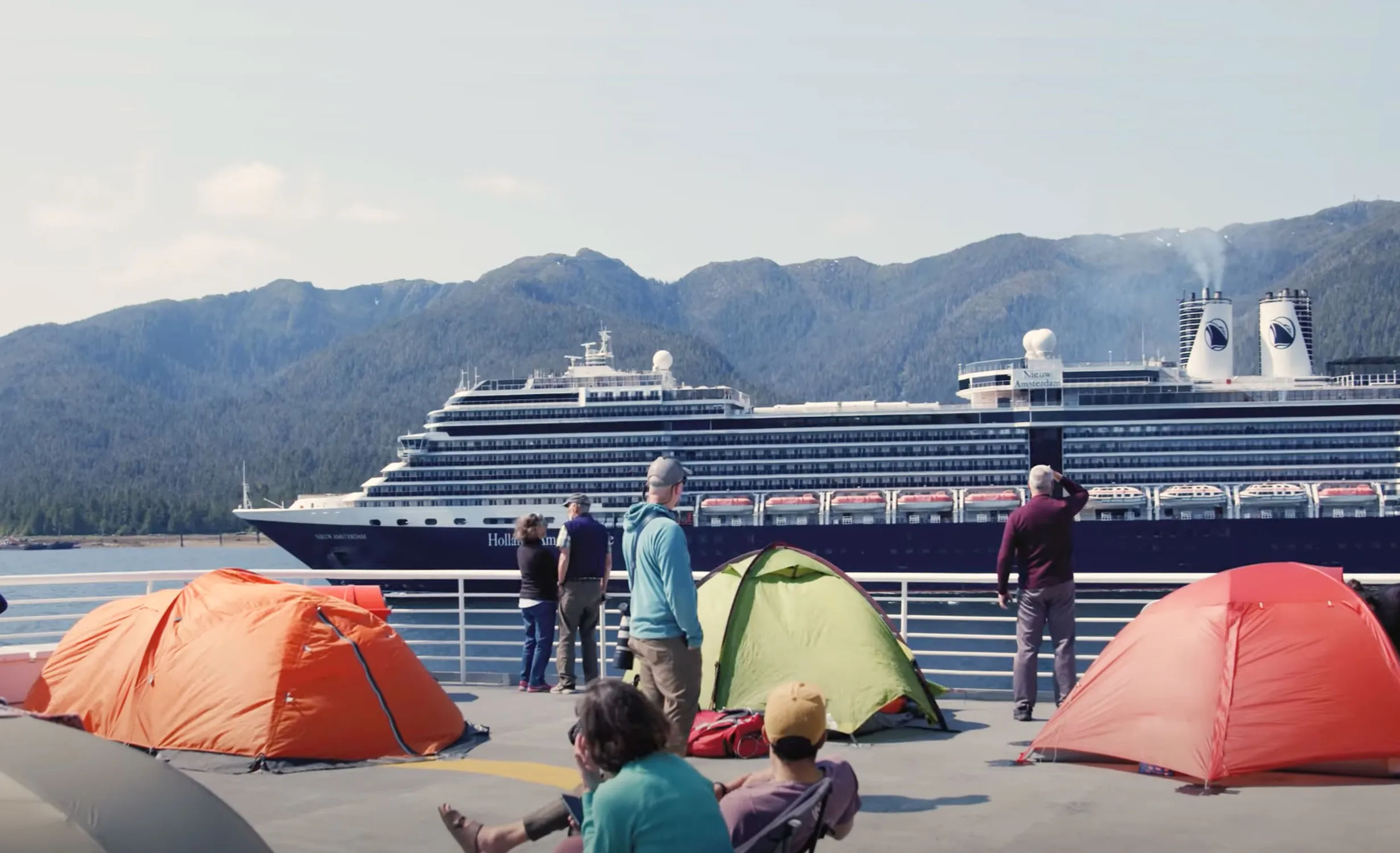
Alaska Marine Highway System
According to my mom, life on the ferry is pretty relaxed once you've started on your way. You'll find open decks and heated solariums for taking in the views of the passing scenery, plenty of fellow travelers to befriend, dining rooms to grab food, and, depending on the boat, kitchen facilities for making your own meals.
Like many cruises, you can spend your days on the Alaska Ferry relaxing, reading a good book, or just reveling in the experience at sea. There are also plenty of new friends to be made, and my mom loved talking to all of the other travelers.
At night, where you sleep depends on how much you're willing to spend on your ticket. If you book a berth, you'll have bunk beds or pullouts in your own private room, depending on the level of accommodation. If you don't, things are a little more cowboy when it comes to sleeping. Recliner lounges and covered solariums are popular sleeping spaces, especially for those who bring their own sleeping bags, pads, or mats. You can also find a set of chairs to sleep across or curl up right on the floor. Others choose to pitch small tents to camp out on the deck, using duct tape to secure them right to the floor.
As for bathrooms, if you've booked a pricier stateroom, you'll have a private bathroom with a shower. If you're sleeping on the deck or in one of the cheaper berths, you'll have access to the public, shared bathrooms with showers on board. There's also coin-operated laundry if needed.
Where Does the Alaska Ferry Go?
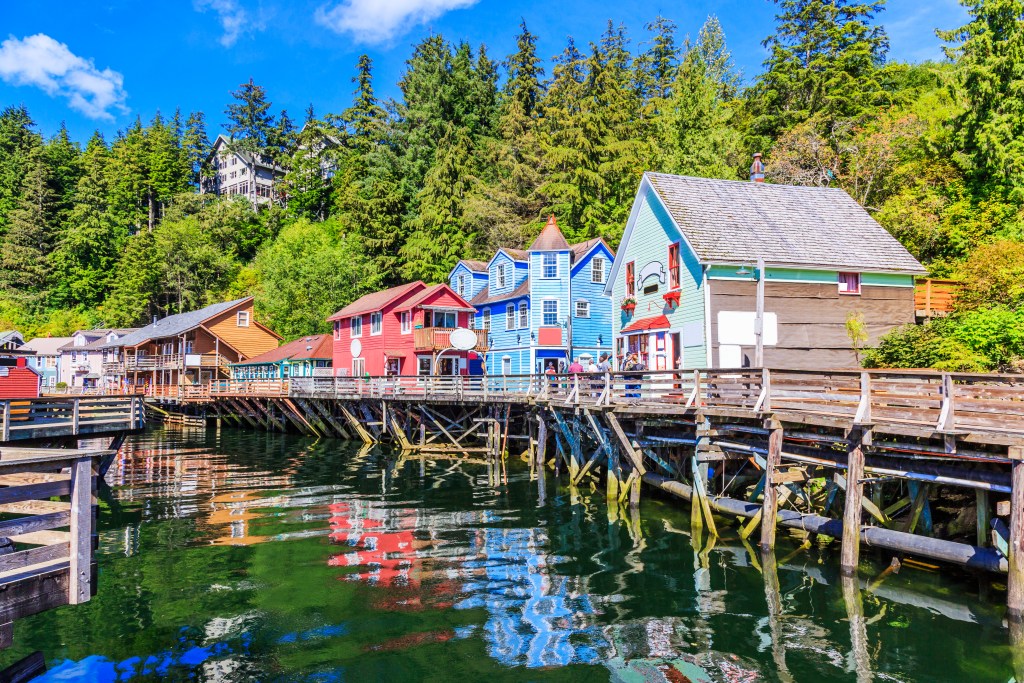
Getty Images, SCStock
All the Alaska ferries depart the Lower 48 from a ferry terminal in Bellingham, Washington, two hours north of Seattle. From there, the boats follow two general ferry routes:
- The first takes the Inside Passage along the coast of British Columbia and southeast Alaska. This route stops in small coastal towns in southeast Alaska, including Ketchikan, Wrangell, Petersburg, Juneau, Sitka, Haines, and Skagway. Most people who take this route fly back from Juneau, either by disembarking in that city or by taking a flight or water taxi back to it from further ports. Ferrying from Bellingham to Junuea takes about 36 hours.
- The other route begins the same along the Inside Passage but then goes farther north, starting in Bellingham and then sailing through the Gulf of Alaska and Prince William Sound to Whittier, outside of Anchorage, with stops in Ketchikan and Juneau. This route gets you where you'll have overland access to most of southcentral Alaska, including the Kenai Peninsula, Anchorage, and Denali. Ferrying from Bellingham to Whitter takes about four days.
Shorter, less-frequent ferry rides connect other places within Alaska, including one out to the very remote Aleutian Islands and Dutch Harbor, as well as routes to Kodiak, Homer, and Valdez in Prince William Sound.
How to Book a Spot on the Alaska Ferry
The first step in booking a spot on the Alaska Ferry through the Alaska Marine Highway System (AMHS) is figuring out your final port of call.
Once you decide where to go, you'll need to determine if you're bringing your own vehicle. All Alaska ferries can transport vehicles, but it's pricey and spots fill quickly. Traveling without a vehicle is the easier and cheaper option and, if you're disembarking in Whitter, cars are relatively easy to rent in Anchorage, an hour and a half west of there. If you have plenty of time and are looking for a truly epic adventure, you might consider taking your RV or camper van on the ferry, then driving back to the Lower 48 on the famous ALCAN highway through Canada, a journey that can take anywhere from five days to two weeks.
No matter your plan, make sure you book your reservation as early as you can. AMHS ferries run year-round with two ferries leaving Bellingham each week during the summer months and a more sporadic schedule in the off-season. They all book up quickly, between the growing number of tourists and the many Alaskans who rely on the ferry to ship vehicles or themselves north.
How Much Is the Ferry From Washington to Alaska?
The cost of the ferry depends on three main factors:
- Your destination port
- Your accommodations for sleeping
- Whether you're bringing a vehicle
For example, an adult ticket to take the ferry from Bellingham, WA to Juneau, AK—a journey of about three days—without sleeping or vehicle arrangements costs $595 (with discounts for children and seniors).
If you don't want to sleep on the deck and instead want a berth, that will cost an extra $200 to $1,000 depending on the facilities and size of the room.
A vehicle costs an additional $1,600 for a car. Vehicles larger than a normal size car or truck, like an RV, cost more depending on the length and there are only a certain number of spots available on each ferry. You can also take bikes and kayaks on the ferry for additional costs.
If you want to take the Washington ferry to the northernmost Alaska port of Whittier, a base adult ticket is $952 with an additional $248 to $1,177 for a berth.
Ferry fares can be estimated using the Alaska Ferry Calculator.
Washington to Alaska Ferry FAQs
While in transit, the ferry runs 24 hours a day, but the length of the journey depends on where you disembark.
The first stop, Ketchikan, takes about 36 hours to cover the approximately 660 miles from Bellingham. The port of Juneau, in the capital of Alaska, takes around three days to travel over 800 miles. If you take the ferry to the furthest Alaska port of Whittier, located 1,300 miles from Bellingham, it takes nearly four days to arrive.
Though the ferry travels along the Canadian coastline, you do not need a passport as you won't be disembarking in Canada. The ferry departs a US port in Washington and arrives in another US port in Alaska. You will need a government-issued photo ID (e.g. driver's license) to board the ferry—though, of course, a passport would also qualify.
If you plan to drive back to the Lower 48 in your own car, you will need your passport, as you'll be entering and traveling through Canada and crossing the US border back into the Lower 48.
Regardless, it's always smart to travel with your passport if you have one.
Technically, yes, pets are allowed on the Alaska ferry for a fee. They must be contained in a carrier or a vehicle on the car deck during transit. There are times throughout the day when you are allowed to go down into the car deck to check on your pets during the journey.
That said, there's no great place on board for animals to relieve themselves, and owners are responsible for cleaning up any messes. Unless you're moving or planning to spend a long time in Alaska, it's best you leave your pets at home.
Unfortunately, you're not allowed to sleep in your vehicle while it's aboard the ship. In fact, you can only access your vehicle at specific times dictated by the crew during the trip, so you can't sleep in your car or van, say, as a way of avoiding the cost of a berth.
Whatever ferry you take will make multiple stops to make in Alaska, particularly on the longer routes. When the ferry pulls into a port, you'll have up to a few hours to get off and walk around. This is a good way to experience a taste of some of the small, coastal Alaskan towns which are otherwise inaccessible by road. Just make sure you get back on the ferry before it leaves!
Where to Go After You Disembark the Alaska Ferry
What happens after you leave the Alaska Ferry is largely dependent on where you get off, as well as what you want to do and how much time you have.
Most of the stops on the Inside Passage route are small towns with little in the way of road systems, so unless you have a specific reason to go to them, most likely you'll choose to disembark in Juneau. If you're going to Whittier, you'll make stops along the Inside Passage, before heading across the Gulf of Alaska, where you'll stop in Yakutat.
Only two ports, Haines and Whittier, are connected by Alaska's road system to other cities and Canada. When my mom took the ferry, she and my van got off in Haines and then drove to where I live in south-central Alaska. It was a 14-hour drive that she broke up into two days. If you get off in Haines and plan on driving, you'll have to cross into Canada 85 miles outside of Haines, so make sure The others have air services or water taxis back to Juneau, where you can fly back to the Lower 48—just make sure to arrange your way to Juneau before deciding to disembark in a small town.
Additionally, if you disembark in Whittier, you can easily access Anchorage, which is an hour and a half west by car or shuttle. From Anchorage, you can fly back to the Lower 48, drive an hour and a half down to the Kenai Peninsula to fish for salmon, or drive or fly to Fairbanks and drive to Denali National Park from there.
If you're not sure which ferry route or stop will offer you the most bang for your buck, you may want to start researching your sea journey based on what you'd like to see and do on the land. The options are practically endless in a state as large as Alaska!
READ MORE: Juneau, Alaska: 10 Reasons for Inclusion on Every Bucket List
